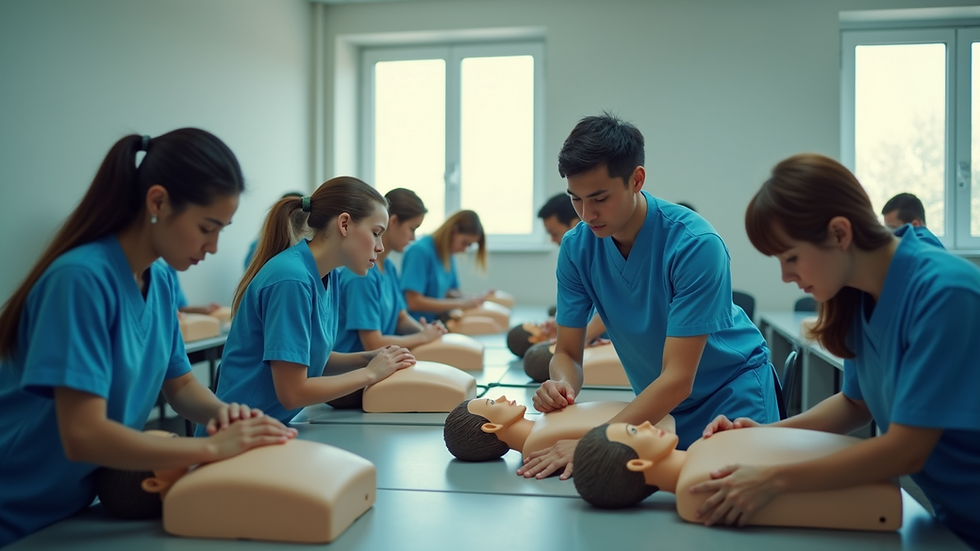Understanding the Benefits of AHA Training Programs
- CPR Instructor
- Sep 17
- 4 min read
When emergencies strike, knowing how to respond quickly and effectively can save lives. AHA training programs provide essential skills in CPR, first aid, and AED use that empower individuals to act confidently in critical situations. These courses are designed to equip participants with practical knowledge and hands-on experience, making them invaluable for workplaces, schools, and communities.
What Is AHA Training and Why Is It Important?
AHA training refers to educational programs developed by the American Heart Association to teach lifesaving techniques. These programs cover a range of topics including cardiopulmonary resuscitation (CPR), automated external defibrillator (AED) use, and first aid. The goal is to prepare people to respond effectively to cardiac emergencies, choking incidents, and other medical crises.
The importance of AHA training lies in its ability to reduce fatalities caused by sudden cardiac arrest and other emergencies. Immediate intervention can double or even triple a victim’s chance of survival. By learning these skills, individuals become first responders who can provide critical care before professional help arrives.
Key benefits of AHA training include:
Increased confidence in handling emergencies
Improved safety in homes, workplaces, and public spaces
Compliance with workplace safety regulations
Enhanced community preparedness

Exploring the Different Types of AHA Training Programs
AHA offers a variety of courses tailored to different needs and skill levels. Whether you are a healthcare professional, teacher, or concerned citizen, there is a program suited for you.
Basic Life Support (BLS)
This course is designed for healthcare providers and includes CPR for adults, children, and infants, as well as AED use and relief of choking. It emphasizes teamwork and effective communication during emergencies.
Heartsaver First Aid CPR AED
Ideal for non-healthcare professionals, this course teaches basic first aid, CPR, and AED skills. It is perfect for workplace safety training or anyone wanting to be prepared for emergencies.
Pediatric Advanced Life Support (PALS)
Focused on healthcare providers who care for infants and children, PALS covers advanced interventions for pediatric emergencies.
Family & Friends CPR
A non-certification course that teaches CPR skills to anyone interested in learning lifesaving techniques for family and friends.
These programs combine video instruction, hands-on practice, and skill assessments to ensure participants gain confidence and competence.

How do I get an AHA certification?
Obtaining an AHA certification involves enrolling in an authorized course and successfully completing the required training and skills tests. Here’s a step-by-step guide:
Choose the right course based on your needs and profession.
Find an authorized training center or online platform offering the course.
Complete the course by attending in-person sessions or online modules.
Demonstrate proficiency in skills such as CPR and AED use during practical assessments.
Pass the written exam if applicable.
Receive your certification card, which is typically valid for two years.
Many organizations require current certification for employment or volunteer roles, so staying up to date is essential. You can find a variety of options by exploring american heart association courses that fit your schedule and learning preferences.

Practical Benefits of AHA Training in Everyday Life
Beyond professional requirements, AHA training offers numerous practical advantages that impact daily life:
Preparedness for family emergencies: Knowing CPR and first aid can help you assist loved ones during accidents or sudden illnesses.
Increased workplace safety: Trained employees can respond to emergencies, reducing injury severity and improving outcomes.
Community impact: Widespread training creates safer neighborhoods where bystanders can act confidently.
Personal empowerment: Learning these skills builds confidence and reduces fear in emergency situations.
For example, a parent trained in CPR can save a choking child, or a coworker certified in AED use can revive someone experiencing cardiac arrest at work. These real-life applications highlight the value of investing time in AHA training.
Tips for Maximizing Your AHA Training Experience
To get the most out of your AHA training, consider the following recommendations:
Practice regularly: Skills like CPR can fade without practice. Use refresher courses or practice sessions to maintain proficiency.
Stay updated: Guidelines and techniques evolve. Keep your certification current and stay informed about changes.
Engage fully: Participate actively in hands-on sessions and ask questions to clarify doubts.
Encourage others: Promote training among family, friends, and colleagues to build a network of prepared individuals.
Use quality resources: Choose accredited training providers to ensure you receive accurate and effective instruction.
By following these tips, you can ensure that your training remains effective and that you are ready to respond when needed.
Lifelong Impact of AHA Training Programs
AHA training programs do more than teach skills - they foster a culture of safety and responsibility. Graduates often report increased confidence and a sense of empowerment that extends beyond emergencies. This knowledge can influence how people approach health and safety in their communities.
Moreover, widespread AHA training contributes to public health by increasing survival rates from cardiac events and other emergencies. It encourages proactive behavior and helps build resilient communities.
Investing in AHA training is an investment in personal and public well-being. Whether for professional development or personal growth, these programs provide tools that can make a life-or-death difference.
By understanding the benefits and opportunities offered by AHA training programs, you can take meaningful steps toward becoming a capable and confident responder in emergencies. Explore available courses today and join the movement to save lives.




Comments